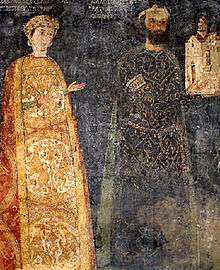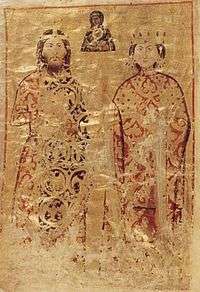Sebastokrator
Sebastokratōr (Greek: σεβαστοκράτωρ; Bulgarian and Serbian: Севастократор; both pronounced sevastokrator) was a senior court title in the late Byzantine Empire. It was also used by other rulers whose states bordered the Empire or were within its sphere of influence (Bulgarian Empire, Serbian Empire). The word is a compound of "sebastos" ("venerable", the Greek equivalent of the Latin Augustus) and "kratōr" ("ruler", the same element as is found in "autokratōr", "emperor"). The wife of a sebastokratōr was named sebastokratorissa (Greek: σεβαστοκρατόρισσα) in Greek or sevastokratitsa (Cyrillic: севастократица) in Serbian and Bulgarian.
History
The title was created by Emperor Alexios I Komnenos (r. 1081–1118) to honour his elder brother Isaac Komnenos.[1] According to Anna Komnene, Alexios did this to raise Isaac above the rank of Caesar, which he had already promised to his brother-in-law, Nikephoros Melissenos. Anna Komnene compares the rank of sebastokratōr to "a second emperor", and also records that along with the Caesar a sebastokratōr was granted the right to wear a crown (but not the imperial diadem).[2] During the Komnenian dynasty (1081–1185), the title continued to be the highest below that of Emperor until 1163, when Emperor Manuel I created the title of despotēs. During that period, it was given exclusively to members of the imperial family, chiefly younger sons of the emperor.[1]
After the dismemberment of the Byzantine Empire by the Fourth Crusade in 1204, the title was adopted in the Latin Empire, the Empire of Nicaea, and the Bulgarian Empire. In Nicaea and the post-1261 restored Byzantine Empire, the title remained one of the highest court dignities, and was almost always restricted to members of the imperial family. The last known holder of the title was Demetrios Kantakouzenos, a ruler in the Peloponnese in the late 14th century.[1]
According to the sources, the distinctive colour associated with the title was blue: the sebastokratōr′s ceremonial costume included blue stockings and blue boots. In circa 1260, according to George Akropolites, the sebastokratores who were members of the imperial family were distinguished from those who were not by having embroidered golden eagles on their shoes.[3] By the time of pseudo-Kodinos in the mid-14th century, the embroidered eagles on a red field were standard. According to Kodinos, the ceremonial costume also included a red tunic (chlamys) and crown (stephanos) of red and gold.[4] The sebastokratōr also had the prerogative of signing documents with a special blue ink.[1]
Bulgaria
Kaloyan inherited the title possibly from his father Aleksandar (d. after 1232), a son of Ivan Asen I of Bulgaria (r. 1189–1196).[5]
Serbia
This title was also adopted in the court of medieval Serbia, under the Nemanjić dynasty, the Serbian Kings and Emperors (1217–1346; 1346–1371).
List of holders
- This list is incomplete; you can help by expanding it.
- Aleksandar Asen (d. after 1232), Bulgarian prince
- Kaloyan (fl. 1259), Bulgarian magnate, held Sofia
- Dejan (fl. 1346-1356), Serbian magnate, held Žegligovo and Preševo
- Alexios III Angelos, Byzantine
- John Angelos, Byzantine
- Sabas Asidenos, Byzantine and Nicaean magnate
- Conon de Béthune, French crusader
- Constantine Doukas of Thessaly
- John Doukas, Byzantine
- Stephen Gabrielopoulos, Byzantine
- John I Doukas of Thessaly, Byzantine
- John II Doukas of Thessaly, Byzantine
- Demetrios I Kantakouzenos, Byzantine
- Andronikos Komnenos (son of John II)
- Isaac Komnenos (brother of Alexios I), Byzantine
- Isaac Komnenos (son of Alexios I), Byzantine
- Isaac Komnenos (son of John II), Byzantine
- Branko Mladenović, Serbian
- Momchil, brigand in Rhodopes
- Stefan the First-Crowned, Serbian
- Jovan Oliver, Serbian
- Constantine Palaiologos (half-brother of Michael VIII), Byzantine
- John Palaiologos (brother of Michael VIII), Byzantine
- Vlatko Paskačić, Serbian
- John Petraliphas, Byzantine
- Strez, Bulgarian
- Blasius Matarango (fl. 1358–67), Albanian nobleman , prince of Karavasta region
Gallery
-

Donor portrait of the Bulgarian sebastokratōr Kaloyan and his wife Desislava, fresco from the Boyana Church (1259).
-

The sebastokratōr Constantine Palaiologos and his wife Eirene. Donor portrait from an early 14th-century monastery typikon.[1]
-

A Byzantine fresco in the Chora Church depicting the sebastokratōr Isaac Komnenos, son of Emperor Alexios I Komnenos.
-

The Sevastokrator Jovan Oliver, fresco from the Lesnovo monastery.
- ^ Note the distinctive stephanos, as well as the red chlamys embroidered with golden double-headed eagles, worn over the kabbadion kaftan.
References
- 1 2 3 4 Kazhdan 1991, p. 1862.
- ↑ Anna Komnene. Alexiad, 3.4.
- ↑ Macrides 2007, pp. 350, 366–367.
- ↑ Parani 2003, pp. 63, 67–69, 72.
- ↑ Bakalov, Georgi; Milen Kumanov (2003). "КАЛОЯН (неизв.-след 1259)". Електронно издание "История на България" (in Bulgarian). Sofia: Trud, Sirma. ISBN 954528613X.
Sources
- Kazhdan, Alexander, ed. (1991). The Oxford Dictionary of Byzantium. New York and Oxford: Oxford University Press. ISBN 978-0-19-504652-6.
- Macrides, Ruth (2007). George Akropolites: The History. Oxford: Oxford University Press. ISBN 978-0-19-921067-1.
- Parani, Maria G. (2003). Reconstructing the Reality of Images: Byzantine Material Culture and Religious Iconography (11th to 15th Centuries). Leiden: Brill. ISBN 978-90-04-12462-2.